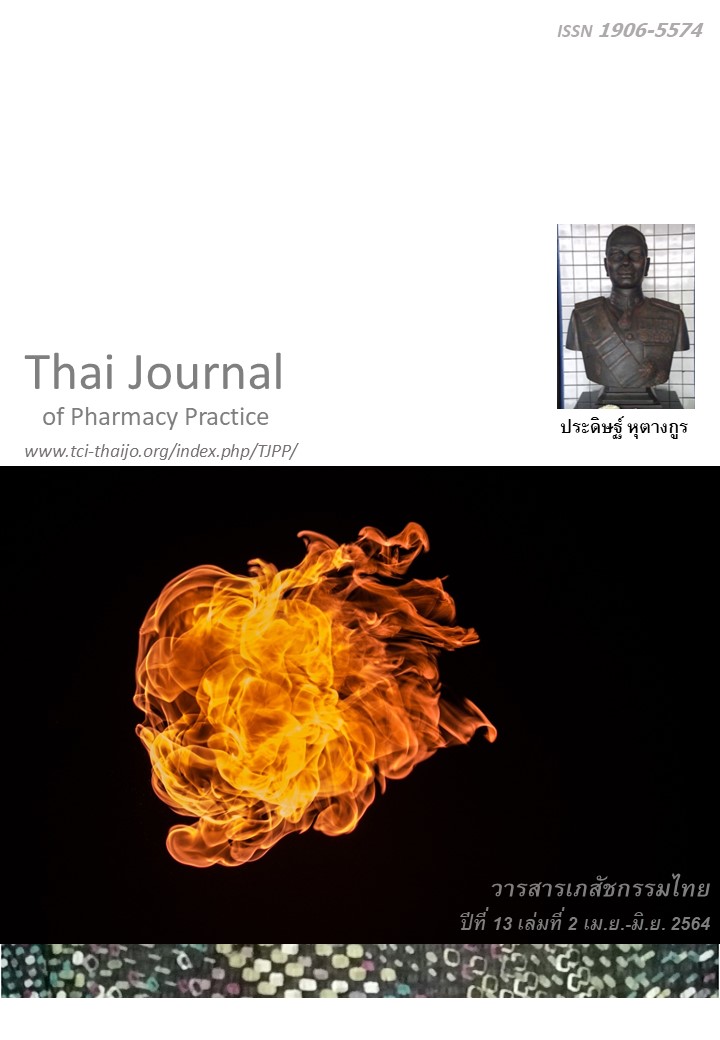ผลการพัฒนาและนำวีดิทัศน์สอนพ่นยาชนิด Metered Dose Inhaler (MDI) ภาษากะเหรี่ยงมาใช้ในผู้ป่วยโรคปอดอุดกั้นเรื้อรังของโรงพยาบาลท่าสองยาง
Main Article Content
บทคัดย่อ
วัตถุประสงค์: เพื่อพัฒนาและประเมินวีดิทัศน์สอนพ่นยาชนิด MDI ภาษากะเหรี่ยงในผู้ป่วยโรคปอดอุดกั้นเรื้อรังของโรงพยาบาลท่าสองยาง วิธีการ: ผู้วิจัยพัฒนาวีดิทัศน์สอนพ่นยาชนิด MDI ภาษากะเหรี่ยง โดยมีเนื้อหาอ้างอิงตามคู่มือของสภาเภสัชกรรม พ.ศ. 2562 ตัวอย่าง คือ ผู้ป่วยชาวกะเหรี่ยงที่ได้รับการวินิจฉัยจากแพทย์ว่าเป็นโรคปอดอุดกั้นเรื้อรัง สื่อสารภาษาไทยไม่ได้ อายุตั้งแต่ 18 ปีขึ้นไป มารับบริการ ณ คลินิกโรคปอดอุดกั้นเรื้อรังทุกวันจันทร์ระหว่างวันที่ 11 พฤศจิกายน ถึง 2 ธันวาคม พ.ศ. 2562 และได้รับการรักษาด้วยยาสูดพ่นชนิด MDI มาแล้วอย่างน้อย 1 เดือน ผู้วิจัยให้ตัวอย่างแสดงวิธีการพ่นยาให้ดู หากประเมินโดยผู้วิจัยว่าพ่นยาไม่ถูกต้องตั้งแต่ 1 ขั้นตอนขึ้นไปจากทั้งหมด 6 ขั้นตอน ตัวอย่างจะได้ดูวีดิทัศน์สอนพ่นยา เมื่อผู้ป่วยดูวีดิทัศน์เสร็จ ให้แสดงการพ่นยาอีกครั้งทันทีแล้วประเมินความถูกต้องของการพ่นยาโดยผู้วิจัย การประเมินก่อนและหลังดูวีดิทัศน์ทำเหมือนกัน การพ่นถูกต้องในแต่ละขั้นตอนจะได้ขั้นตอนละ 1 คะแนนเท่ากัน จากนั้นให้ผู้ป่วยประเมินความพึงพอใจบนสเกล 5 ระดับต่อวีดิทัศน์ผ่านล่ามแปลภาษา ผลการวิจัย: วีดีทัศน์สอนพ่นยาภาษากะเหรี่ยงที่พัฒนาขึ้นมีความยาว 2 นาที เนื้อหาประกอบด้วยการสาธิตการพ่นยา มีเสียงบรรยายภาษากะเหรี่ยงและตัวอักษรภาษาไทยแสดงควบคู่ที่ด้านล่าง มีผู้ผ่านการคัดเลือกเข้าร่วมการศึกษาทั้งหมด 21 คน เพศชายและหญิง เท่ากับ 10 และ 11 คน ตามลำดับ อายุเฉลี่ย 62.86±12.26 ปี ระยะเวลาที่เป็นโรคเฉลี่ย 51.71±45.40 เดือน ไม่มีโรคร่วม และไม่สูบบุหรี่ เท่ากับ 14 และ 17 คน ตามลำดับ มีผู้ที่พ่นยาครั้งแรกถูกต้องทุกขั้นตอน 6 คน จึงเหลือผู้ที่ได้ดูวีดิทัศน์ 15 คน ซึ่งมีคะแนนเฉลี่ยของการพ่นยาถูกต้องก่อนและหลังดูวีดิทัศน์ เท่ากับ 2.4±1.76 และ 4.0±2.14 คะแนน ตามลำดับ ซึ่งแตกต่างกันอย่างมีนัยสำคัญทางสถิติ (P=0.001) คะแนนความพึงพอใจต่อวีดิทัศน์ที่พัฒนาขึ้นเฉลี่ยทุกหัวข้อเท่ากับ 4.05±0.05 คะแนนจากคะแนนเต็ม 5 สรุป: ผู้ป่วยพ่นยาได้ถูกต้องมากขึ้นหลังดูวีดิทัศน์สอนพ่นยาชนิด MDI ภาษากะเหรี่ยงที่พัฒนาขึ้นมา และมีความพึงพอใจต่อวีดิทัศน์ในระดับดี จึงควรนำวีดิทัศน์นี้ไปปรับใช้และเผยแพร่ให้กับโรงพยาบาลอื่นที่มีบริบทเดียวกัน
Article Details
ผลการวิจัยและความคิดเห็นที่ปรากฏในบทความถือเป็นความคิดเห็นและอยู่ในความรับผิดชอบของผู้นิพนธ์ มิใช่ความเห็นหรือความรับผิดชอบของกองบรรณาธิการ หรือคณะเภสัชศาสตร์ มหาวิทยาลัยสงขลานครินทร์ ทั้งนี้ไม่รวมความผิดพลาดอันเกิดจากการพิมพ์ บทความที่ได้รับการเผยแพร่โดยวารสารเภสัชกรรมไทยถือเป็นสิทธิ์ของวารสารฯ
เอกสารอ้างอิง
Ministry of Public Health. HDC report. Morbidity rate of chronic obstructive pulmonary disease [online]. 2019 [cited Nov 22, 2019]. Available from: hdcservice.moph.go.th/hdc/reports/report.php?source=formated/ncd.php&cat_id=6a1fdf282fd28180eed7d1cfe0155e11&id=33b1c30a4652927ac32fee24e8906170.
Global Initiative for Chronic Obstructive Lung Disease. Global strategy for the diagnosis, management, and prevention of chronic obstructive lung disease (2019 report) [online]. 2019 [cited Nov 22, 2019]. Available from: goldcopd.org/wp-content /up loads/2018/11/GOLD-2019-v1.7-FINAL-4Nov20 18-WMS.pdf.
Souza ML, Meneghini AC, Ferraz E, Vianna EO, Borges MC. Knowledge of and technique for using inhalation devices among asthma patients and COPD patients. J Bras Pneumol. 2009; 35: 824-31.
Hesselink AE, Penninx BW, Wijnhoven HA, Kriegsman DM, van Eijk JT. Determinants of an incorrect inhalation technique in patients with asthma or COPD. Scand J Prim Health Care. 2001; 19: 255-60.
Lavorini F, Magnan A, Dubus JC, Voshaar T, Corbetta L, Broeders M, et al. Effect of incorrect use of dry powder inhalers on management of patients with asthma and COPD. Respir Med. 2008; 102: 593-604.
Melani AS, Bonavia M, Cilenti V, Cinti C, Lodi M, Martucci P, et al. Inhaler mishandling remains common in real life and is associated with reduced disease control. Respir Med. 2011; 105: 930-8.
Giraud V, Roche N. Misuse of corticosteroid metered-dose inhaler is associated with decreased asthma stability. Eur Respir J. 2002; 19: 246-51.
Axtell S, Haines S, Fairclough J. Effectiveness of various methods of teaching proper inhaler technique. J Pharm Pract. 2017: 30: 195-201.
Navarre M, Patel H, Johnson CE, Durance A, McMorris M, Bria W, et al. Influence of an interactive computer-based inhaler technique tutorial on patient knowledge and inhaler technique. Ann Pharmacother. 2007; 41: 216-21.
Leiva-Fernández F, Leiva-Fernández J, Zubeldia-Santoyo F, García-Ruiz A, Prados-Torres D, Barnestein-Fonseca P. Efficacy of two educational interventions about inhalation techniques in patients with chronic obstructive pulmonary disease (COPD). TECEPOC: study protocol for a partially randomized controlled trial (preference trial). Trials. 2012; 13: 64.
Aydemir Y. Assessment of the factors affecting the failure to use inhaler devices before and after training. Respir Med. 2015; 109: 451-8.
Shah RF, Gupta RM. Video instruction is more effective than written instruction in improving inhaler technique. Pulm Pharmacol Ther. 2017; 46: 16-9.
Phimarn W, Rattanachotpanit T, Pilalai K, Horadee P, Treephop W, Photijug N. Outcomes of pharmacist counseling with multimedia in adult asthmatic patients. Isan Journal of Pharmaceutical Sciences. 2013; 9: 95-9.
Pansa S, Srichada P, Siwaborwornwattana A, Tedra peemetawenumchai S. Improved clinical outcomes in asthmatic and COPD inhaler users with multimedia-acquired pharmacy counseling. Journal of Health Science. 2016; 25: 436-45.
van der Palen J, Klein JJ, Kerkhoff AH, van Herwaarden CL, Seydel ER. Evaluation of the long-term effectiveness of three instruction modes for inhaling medicines. Patient Educ Couns. 1997; 32 (1 Suppl): S87-95.
Verver S, Poelman M, Bögels A, Chisholm SL, Dekker FW. Effects of instruction by practice assistants on inhaler technique and respiratory symptoms of patients. A controlled randomized videotaped intervention study. Fam Pract. 1996; 13: 35-40.
Pharmacy Council of Thailand. Skills guide based on professional competency criteria of professional pharmacy (core competency) 2019. Nonthaburi: HR Print and Training; 2019.
Batterink J, Dahri K, Aulakh A, Rempel C. Evaluation of the use of inhaled medications by hospital inpatients with chronic obstructive pulmo- nary disease. Can J Hosp Pharm. 2012; 65: 111-8.
Öztürk C1, Kaya A, Bilgin C, Yücesoy L, İkidağ B, Demirel M,et al. Evaluation of inhaler technique and patient satisfaction with fixed-combination budeso nide/formoterol dry-powder inhaler in chronic obstructive pulmonary disease (COPD): data on real-life clinical practice in Turkey. Tuberk Toraks. 2012; 60: 301-13.
Press VG, Arora VM, Shah LM, Lewis SL, Ivy K, Charbeneau J, et al. Misuse of respiratory inhalers in hospitalized patients. J Gen Intern Med. 2011; 26: 635-42.
King TL, Kho EK, Tiong YH, Julaihi SN. Comparison of effectiveness and time-efficiency between multimedia and conventional counselling on metered-dose inhaler technique education. Singa pore Med J. 2015; 56:103-8.
Carpenter DM, Lee C, Blalock SJ, Weaver M, Reuland D, Coyne-Beasley T, et al. Using videos to teach children inhaler technique: a pilot randomized controlled trial. J Asthma. 2015; 52: 81-7.
Savage I, Goodyer L. Providing information on metered dose inhaler technique: is multimedia as effective as print?. Fam Pract. 2003; 20: 552-7.
Wilson EA, Park DC, Curtis LM, Cameron KA, Clayman ML, Makoul G, et al. Media and memory: The efficacy of video and print materials for promoting patient education about asthma. Patient Educ Couns. 2010; 80: 393–8.
von Schantz S, Katajavuori N, Juppo AM. The use of video instructions in patient education promoting correct technique for dry powder inhalers: an investigation on inhaler-naïve individuals. Pharmacy 2018; 6: 1-15.
Mulhall AM, Zafar MA, Record S, Channell H, Panos RJ. A tablet-based multimedia education tool improves provider and subject knowledge of inhaler use techniques. Respir Care. 2017; 62: 163-71.
Bosnic-Anticevich SZ, Sinha H, So S, Reddel HK. Metered-dose inhaler technique: the effect of two educational interventions delivered in community pharmacy over time. J Asthma. 2010; 47: 251-6.
Luedphanithit N. Outcomes of pharmaceutical care in patients with chronic asthma at Dokkhamtai Hospital. Journal of Health Science. 2014; 23: 37-44.
Klijn SL, Hiligsmann M, Evers SMAA, Román-Rodríguez M, van der Molen T, van Boven JFM. Effectiveness and success factors of educational inhaler technique interventions in asthma & COPD patients: a systematic review. NPJ Prim Care Respir Med. 2017; 27: 24.


